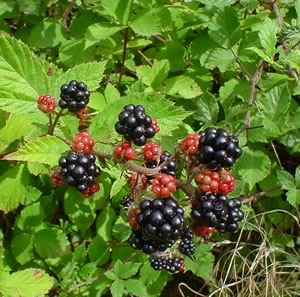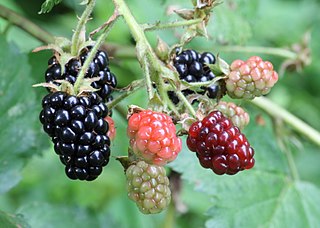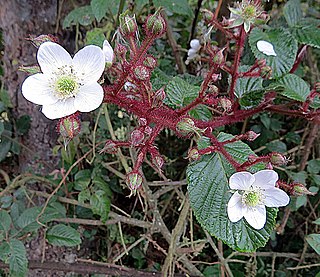
Rubus is a large and diverse genus of flowering plants in the rose family, Rosaceae, subfamily Rosoideae, with over 1,350 species.

In botany, a drupe is an indehiscent type of fruit in which an outer fleshy part surrounds a single shell of hardened endocarp with a seed (kernel) inside. These fruits usually develop from a single carpel, and mostly from flowers with superior ovaries.

The blackberry is an edible fruit produced by many species in the genus Rubus in the family Rosaceae, hybrids among these species within the subgenus Rubus, and hybrids between the subgenera Rubus and Idaeobatus. The taxonomy of blackberries has historically been confused because of hybridization and apomixis, so that species have often been grouped together and called species aggregates. For example, the entire subgenus Rubus has been called the Rubus fruticosus aggregate, although the species R. fruticosus is considered a synonym of R. plicatus.

Rubus phoenicolasius is an Asian species of raspberry in the rose family, native to China, Japan, and Korea.

Rubus caesius is a Eurasian species of dewberry, known as the European dewberry. Like other dewberries, it is a species of flowering plant in the rose family, related to the blackberry and raspberry. It is widely distributed across much of Europe and Asia from Ireland and Portugal as far east as Xinjiang Province in western China. It has also become sparingly naturalized in scattered locations in Argentina, Canada, and the United States.

Rubus saxatilis, or stone bramble, is a species of bramble widespread across Europe and Asia from Iceland and Spain east as far as China. It has also been found in Greenland.

Rubus armeniacus, the Himalayan blackberry or Armenian blackberry, is a species of Rubus in the blackberry group Rubus subgenus Rubus series Discolores Focke. It is native to Armenia and Northern Iran, and widely naturalised elsewhere. Both its scientific name and origin have been the subject of much confusion, with much of the literature referring to it as either Rubus procerus or Rubus discolor, and often mistakenly citing its origin as western European. Flora of North America, published in 2014, considers the taxonomy unsettled, and tentatively uses the older name Rubus bifrons.

Rubus ulmifolius is a species of wild blackberry known by the English common name elmleaf blackberry or thornless blackberry and the Spanish common name zarzamora. It is native to Europe and North Africa, and has also become naturalized in parts of the United States, Australia, and southern South America.

Rubus canadensis is a North American species of flowering plant in the rose family known by the common names smooth blackberry, Canadian blackberry, thornless blackberry and smooth highbush blackberry. It is native to central and eastern Canada and the eastern United States.

Rubus flagellaris, the northern dewberry, also known as the common dewberry, is a North American species perennial subshrub species of dewberry, in the rose family. This dewberry is distributed across much of Canada, Mexico, and the United States. It grows in diverse habitats ranging from drier savannas to temperate deciduous forests.

Rubus argutus is a North American species of prickly bramble in the rose family. It is a perennial plant native to the eastern and south-central United States. Common names are sawtooth blackberry or tall blackberry after its high growth.
Diastatea is a genus of plants native to Latin America, mostly in Mexico and Central America but with one species extending southward along the Andes to Argentina.
- Diastatea costaricensisMcVaugh - Guatemala, Honduras, Nicaragua, Costa Rica
- Diastatea expansaMcVaugh - central Mexico
- Diastatea ghiesbreghtii(Kuntze) E.Wimm - southwestern Mexico
- Diastatea micrantha(Kunth) McVaugh - widespread from central Mexico to the Jujuy region of northern Argentina
- Diastatea tenera(A.Gray) McVaugh - southern Mexico and Guatemala
- Diastatea virgataScheidw. - southern Mexico
Rubus trilobus, the boulder raspberry or delicious raspberry, is Mesoamerican species of flowering plant in the rose family. It is native to Guatemala and to southern and central Mexico.
Rubus glabratus is a Latin American species of brambles in the rose family. It is native to Central America and South America.

Rubus adenotrichos is a Mesoamerican species of brambles in the rose family. It grows in Central America, northwestern South America, and central and southern Mexico, from Michoacán and Veracruz south to Ecuador and Venezuela.
Rubus irasuensis is a Mesoamerican species of brambles in the rose family. It grows in southern Mexico (Chiapas) and in Central America.
Rubus macrogongylus is a Mesoamerican species of brambles in the rose family. It grows in the State of Chiapas in southern Mexico as well as in the Central American nations of Guatemala and Nicaragua.
Rubus alpinus is a New World species of brambles in the rose family. It grows in Jamaica, Costa Rica, Guatemala, Colombia, Honduras, Panamá, Venezuela, and the 3 Guianas.
Rubus sapidus is a Mesoamerican species of brambles in the rose family. It grows in southern Mexico and Central America.
Rubus fagifolius is a Mesoamerican species of brambles in the rose family. It grows in southern Mexico and Central America.












